MAP Test
The MAP (Measure of Academic Progress) test is a computerized, adaptive test that is administered to children from preschool to 12th grade. Since each student has certain academic strengths and weaknesses which affect their ability to grow, this test was developed as a tool to pinpoint what those strengths and weaknesses are and where the student stands academically. This helps teachers and educators understand how to effectively approach each specific student and ensure their progress. The test is typically given to students three times a year: at the start, middle, and end of the year. Here you can find all the information you'll need in order to understand what the test is, what it's used for, how it's administered and what your child can expect.
History of the Company
The MAP test was developed by NWEA (Northwest Evaluation Association), a not-for-profit organization which aims to provide educators with the best tools to assess students' academic growth and proficiency. Founded in 1977 by Allan Olson and George Ingebo, NWEA has been researching and developing testing for students from preschool to 12th grade for the past four decades. Their goal was to find a new method of testing that would measure a child's academic growth which could be used to improve the way educators teach their students. In 2000, NWEA developed the MAP test, and their tools and methods are currently being used by educators in 145 countries worldwide.
About the NWEA Growth MAP Test
| Test name (Grade) | Number of Questions | Duration (minutes) | Question Subjects | Type of Questions | Measured Skills |
|---|---|---|---|---|---|
| Language Usage (2-12) | 50 - 53 | 45 - 60 | Writing, Grammar, Spelling, Punctuation, Research | Drag-and-Drop, Multiple Choice, Short Answer/Correction, Multiple Response | Writing and Grammar |
| Reading (K-2) | 43 | 15 – 30 | Informational Text, Vocabulary, Literature | Drag-and-Drop, Multiple Choice, Multiple Response | Reading Comprehension and Vocabulary |
| Reading (2-5) | 40 - 43 | 45 - 60 | |||
| Reading (6-12) | 40 - 43 | 45 - 60 | |||
| Math (K-2) | 43 | 15 - 30 | Algebra, Geometry, Statistics, Probability, Problem Solving | Drag-and-Drop, Multiple Choice, Short Answer | Number Sense, Estimation, Problem Solving |
| Math (2-5) | 47 - 53 | 45 - 60 | |||
| Math (6-12) | 47 - 53 | 45 - 60 | |||
| Science (3-5) | 39 - 42 | 45 - 60 | Life Sciences, Earth and Space Sciences, Physical Sciences | Drag-and-Drop, Multiple Choice, Multiple Response | Understanding of Physical, Life, Earth, and Space Sciences |
| Science (6-8) | 39 - 42 | 45 - 60 | |||
| Science (9-12) | 39 - 42 | 45 - 60 | |||
| Start Practicing Now | |||||
What Is the MAP Test?
MAP (Measure of Academic Progress) is a computerized test which is used to determine a student's academic progress throughout a particular year and to help educators identify a student's academic strengths and weaknesses. The MAP test is adaptive, meaning the difficulty of the following question is determined by the student's answer to the previous question. For example, if a student answers a question correctly, the next question's difficulty level will go up. This method ensures that each test is uniquely tailored to the specific student taking the test, which in turn reflects the student's proficiency in the given subject. Therefore, educators can pinpoint a student's strengths and weaknesses and understand how to better educate the student.
For grades K-2, the MAP tests available are Reading and Math. For grades 2-12, the MAP tests available are Language Usage, Reading, Math, and Science. Second-graders are considered to be in a transitional stage academically, so whether they are tested with the K-2 tests or the 2-12 tests in Reading, and Math depends on their previous RIT score in the given subject.
Math
The NWEA MAP Math Test measures your child's academic progress in mathematics. The test level, duration, and number of questions vary depending on the grade level and the number of correct answers provided by your child. For the youngest grades (K-2), the total number of questions is 43 and the test duration is 30 minutes at the most. For grades 2-12, the number of questions increases to 47-53 questions, and the test duration can reach 60 minutes. The topics are adapted according to the class and the student's level.
If you are looking for more information about the MAP Mathematics Test, please visit the dedicated page. You will find a thorough overview of the test as well as free questions for each grade.
Want to purchase a complete preparation? Start Practicing the MAP Test online now.
Reading
The NWEA MAP Reading Test is used by teachers to measure growth during a student's school years. The number of questions varies from 40 to 43 depending on the student's grade and level. For younger students, the maximum duration is 30 minutes, and for older classes, 60 minutes at the most. Topics include informational texts, vocabulary, and literature, again according to the grade level.
For more information and free samples for the MAP Reading Test, please visit the MAP Reading Test page.
To give your child the best chance of success, purchase a complete online preparation for the MAP Reading Test here.
Language Usage
The NWEA MAP Language Usage Test is administered to second graders and above. The assessment has between 50 and 53 questions and takes approximately 45-60 minutes to complete. Topics include grammar, writing strategies and styles, as well as language mechanics.
For more information about the MAP Language Usage Test, free sample questions for each grade, and the NWEA last students' scores in this section, go to the dedicated page.
Ready to practice? Start practicing for the MAP Test online right now!
Science
NWEA has also developed a Science MAP Test which is less common than Reading, Language Usage, and Math MAP tests in most schools. There are three versions of the test, one for each grade group – 3-5, 6-8, and 9-12. Students are tested on their understanding of different area of science such as Life Sciences, Physical Science, and Earth and Space Science.
Who Needs to Take the MAP Test?
The MAP test is essential for children of all ages to take in order for them to receive the most effective education from their teachers. Teachers can use their students' scores to understand what they are already knowledgeable about and what they may need to spend more time on. Likewise, students' scores can give educators an insight into their class or school's academic performance as a whole. Parents receive a performance report that will include their child's score which they can compare to the median scores that are published by NWEA each year.
MAP Test Scores Explained
The MAP test scores are measured in RIT (Rasch unIT), which is a scoring system developed by NWEA to measure a student's academic progress. These scores are not goals, but rather the average scores of students in a given point in time during their school year. Much like how a child's height is measured as they grow, the RIT score can be tracked each time a student takes a MAP test to see and compare their growth from their previous score. The score is a prediction that a student will answer 50% of given questions correctly at a specific difficulty level. Results are measured on a scale at regular intervals, which means that the difference between scores remains consistent whether a student scores high or low. It also means that grade level is irrelevant. Since the MAP test is administered on a computer, the results are instantly available once the child has completed the test.
Once the test is taken, teachers and schools can generate many forms of test reports, some comparing the scores and progress of a single student over the years, other comparing the results of students in the same class, and others comparing results by school or by district. A simplified report for families also exists and can be shared with parents to help them understand and track their child's progress. Teachers use the MAP Test Scores to tailor their classroom lessons and establish goals for their students.
Commonly Used Terms for the MAP Reports
Before analyzing some of the most commonly used forms of test reports for parents by teachers, it is important to understand what elements are used in these reports and to understand their functions:
RIT
As discussed previously, the RIT is a scoring system that was developed by the NWEA. This tool is used to measure students' performance over time, both against their past performance and against the performance of other students. RIT scores range between approximatively 100 and 350. Most students reach RIT scores between 180 and 200 in third grade at age 8/9 and then progress to scores ranging from 220 to 260 by the time they reach high school.
District Average/District Grade Level Mean RIT
The district average is the average RIT result for all students in the same grade and in the same school district who were tested concurrently with your child.
Norm Group Average/Norm Grade Level Mean RIT
Average score of students attending the same class and being tested in the same term, according to the latest NWEA standardization study.
Percentile (Rank and Range)
Percentiles are used for comparing a student's achievement to that of the Norm Group. The percentile indicates that the student performed as well as or better than the submitted percentage of students from the same grade who participated in the MAP Test. For example, a student who scored at a percentile rank of 72 did as well as or better than 72% of the students in the Norm Group. The probability that a student's percentile rank will again fall within this range is about 68% if the student retakes the test in a relatively short time. Percentile range is calculated by determining the percentile ranks of the lower and upper end of the RIT score scale.
Lexile®/Lexile range
The Lexile reading range is the range of texts a student would be likely to grasp when reading independently. More information on the dedicated page.
Projected RIT score or RIT projection
The projected future score for a student showing typical growth, based on the NWEA national MAP Growth Standards. Projections include the student's initial score, grade level, and time from test to test.
Standards
Standards are principles established by states or districts regarding the knowledge and skills of students in specific academic topics and disciplines.
Achievement
The extent to which your child has gained proficiency in a subject relative to similar students across the country.
Similar students/academic peers
Children with the same starting RIT score, the equivalent number of instruction weeks, and within the same grade.
Term/Year + Grade
Provides the term, year, and grade in which the test took place. A term that spans more than one year will be represented by the latter of the two years.
- FA (Fall)
- WI (Winter)
- SP (Spring)
- SU (Summer)
Growth
An overview of your child's personal academic progress throughout the year.
RIT Growth
The growth in RIT points achieved by the student between both periods during the Growth Comparison Period.
Growth Projection
The average growth of similar students who started the same term with a similar RIT score, based on the NWEA norms study.
What Is the MAP Family Report and How to Read It?
The Family Report is used to display a student's key results with the student and his/her parents. It summarizes the child's academic performance based on his or her results on the most recent MAP test. Separate results can be found for each of the disciplines tested by the MAP Growth Test. It also includes a prediction or projection of the student's level for the next State Test or a "College Readiness Projection" for the SAT (only for grades 5-9) and ACT (grade 10).
For example, for the mathematics discipline:
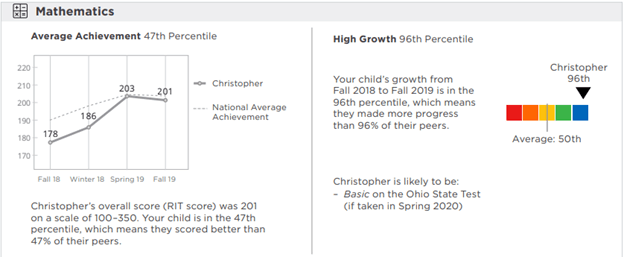
For the Reading discipline:
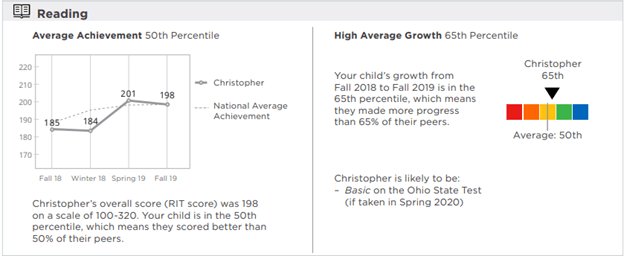
For the Science discipline:
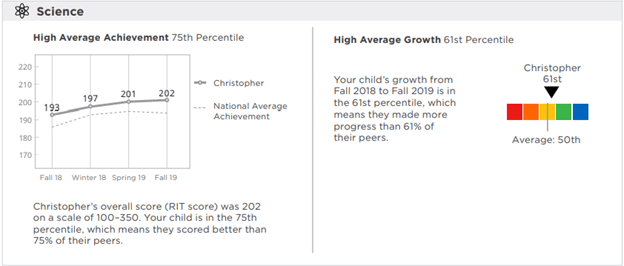
The following table illustrates the different percentile ranges and their values:
| Percentile Ranking Color Key | ||||
| ← 20 | 21-40 | 41-60 | 61-80 | 81 → |
| Low | Low Average | Average | High Average | High |
| Lo | LowAvg | Avg | HiAvg | Hi |
Find a detailed family report scores sample for the MAP Test here.
What Is the MAP Progress Report?

A student's MAP Progress Report will often include graphs, descriptors, and tables for the teacher. The graphs are separated by subject and include the student's individual progress, average district student progress, average national student progress, and the student's predicted future progress. The descriptors located under each graph provide the student's RIT scores in specific subjects within the test. The tables are also separated by subject and include the students RIT score and predicted RIT score range that the student could receive if the test were retaken, RIT growth from one semester to the next, and the predicted growth of the student.
How to Prepare for the MAP Test
Successfully taking the NWEA MAP Test is important for students, as the results of this test determine their level and education for the months following the test. For this reason, taking the time to properly prepare for the test is essential. By practicing for the MAP Test, the students will have a better understanding of what to expect on the actual test day, which will help the teachers and families to get a more accurate picture of their true abilities and potential.
The most efficient way to prepare for the MAP test is to practice, so we offer practice MAP tests for every grade and subject. Our MAP practice tests are designed to be as close to a real MAP test as possible and can give students an idea of what to expect. It's best to take these practice tests as if they were the real deal – no distractions, no breaks, and no searching online for answers. Also, understanding how the MAP test itself will look and getting familiar with the tools provided during the test can also be extremely helpful in preparing for it, as it reduces stress levels and helps the students concentrate on the questions.
What Is the Student Profile Report?
The Growth Module of the Student Profile Report, which is available with MAP Growth, is a tool which enables both students and teachers to establish goals with specifically and accurately.
This tool supports educators in focusing on meaningful and achievable goals which are based on their students' growth objectives. It is an interactive online report, unlike the Family Report and the Progress Report. All previous data on the student is compiled in a visual and graphical display allowing the teacher and the student to determine together the objectives to be reached for the upcoming exam.
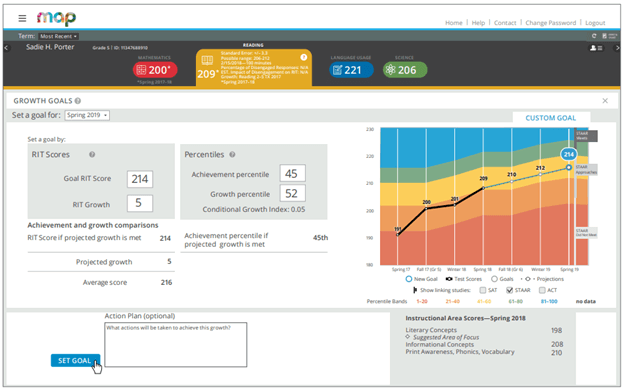
Tips and Tricks
Here are some helpful tips and tricks to help students prepare for the MAP test.
- Since the MAP test is meant to evaluate a student's academic growth unlike other tests, it is important to keep in mind that it is perfectly fine to answer a question incorrectly if you do not know the answer. After all, the purpose of the test is to understand where the child stands, not for the child to answer all the questions correctly.
- Another important aspect about the MAP test which should be kept in mind is that it is untimed. Therefore, there is no need to hurry through the test and feel pressure to answer as many questions as possible. Keeping these two tips in mind can ease pressure while taking the test.
- It is important to note that once a question has been answered, the student cannot go back and view it again or change their answer. Therefore, it is vital to read the question carefully and make sure you understand it before answering and double check that the answer selected is the one intended.
- Comfort and the ability to focus are very important when taking any test, let alone the MAP test. Therefore, it is important to get a good night's sleep the night before the MAP test and to bring a jacket just in case the classroom gets too cold during testing.
- Preparation is key. A student who has been practicing the different topics and types of questions on the MAP Test will be much more confident and calmer when compared to one who has never experienced such questions before.
FAQs
How long does my child have to complete the MAP test?
The MAP test is not timed, so your child doesn't have a fixed amount of time to finish the test. It usually takes children approximately up to one hour to complete the test.
How often will my child have to take the MAP test?
Depending on the school district, the MAP test can be administered up to four times per year. Usually, districts tests students once at the beginning of the school year and once at the end of the school year.
Is my child allowed to use a calculator during the Math portion of the test?
Students cannot bring their own calculator to use, but a virtual calculator is provided in the exam for some questions. If a calculator cannot be used for a certain question, the calculator option in the exam will not be available.
How is my child's score used by the teacher?
Teachers use the MAP scores to understand students' academic proficiency and growth. The scores are used by the teachers to adapt their teaching methods to meet the students' academic needs so they can continue to grow and learn.
What does it mean that the MAP test is adaptive?
The MAP test is adaptive in that the difficulty of the questions depends on the student's answer to the previous questions. If the student answered the question correctly, the following question will be more difficult.
Can MAP help determine if my child is gifted?
A child with a 95 percentile on the MAP assessment in reading or math is recognized as gifted in these areas. Students may be identified as gifted in math and/or reading on any of the assessments during the school year.
Does MAP testing count as a grade?
MAP tests are independent of students' grades and are adapted to each student's level based on the answers they provide on the test itself.
What is the MAP Testing Screening Assessment?
MAP Screening Tests or Screening Assessments are MAP tests given to students usually once at the end of pre-K or when the child enters Kindergarten. They provide baseline information for a new student entering the early stages of learning. They present only 19 to 20 questions and produce only a single overall score for the subject. Those tests are not recommended for growth measurement.
What is the MAP maximum score?
Although the maximum MAP Test RIT score is 350, this does not mean that a student can achieve this score or that 350 is the maximum score for a MAP Growth Test. Indeed, there is no such thing as a perfect score, as the NWEA MAP Test score is a function of the questions answered and their difficulty. Since the assessment is adaptive, it adjusts itself accordingly to the student's answers to generate an inferred score that matches the student's level.
Is there MAP testing in high school?
Most schools test students annually at least twice a year, from grades K through 12.
Can I take the MAP test at home?
The MAP test can be assigned at home for homeschoolers. In addition, due to the pandemic and the subsequent online schooling, the MAP Tests were distributed to students at home online during the Covid-19 outbreak.
What is a good score on the MAP test?
The MAP RIT score is an indication of the questions difficulty for which about half were answered correctly by the student. The score differs between grades and according to the child's age. Concretely, high scores can usually range from 240 to 265 on the Reading MAP Test and from 250 to 285 on the Math MAP Test.
How do I take the NWEA test?
To take the test, go to test.mapnwea.org. If an "Oops! Where's my test window?" window appears, unblock the pop-up blocker in your browser's address bar. You can then log in with your username and password.
Can I take a break during the MAP Test?
You may take a break of up to 25 minutes during the test. Find all the information in the table below.

Can I guess answers in the MAP Test?
If you guess many questions quickly, your test will automatically stop and the Sloth Slow Down will appear. The proctor or teacher will also receive a notification, as you are demonstrating a lack of effort and not a lack of knowledge. If you reach the excessive speed guessing threshold, you will have to retake the test. It is important to understand that the MAP Test analyzes your knowledge in order to know what your level is and what you need to learn during the school year. Guessing is useless on this test and can only harm you and your education.
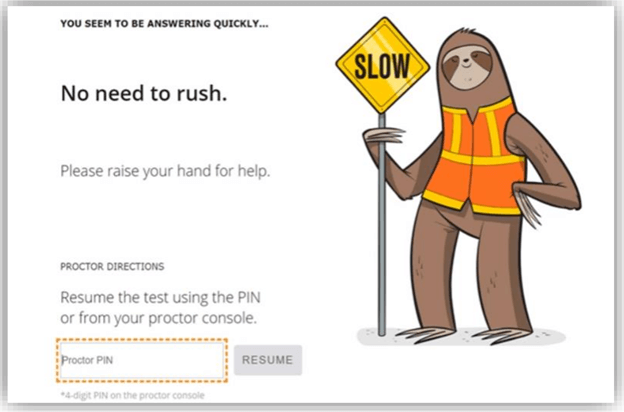
What states do MAP testing?
The following states administer the NWEA MAP Test to their students:
- Alabama
- Alaska
- Arizona
- Arkansas
- California
- CCSS
- Colorado
- Connecticut
- Delaware
- District of Columbia
- Florida
- Georgia
- Hawaii
- Idaho
- Illinois
- Indiana
- Iowa
- Kansas
- Kentucky
- Louisiana
- Maine
- Maryland
- Massachusetts
- Michigan
- Minnesota
- Mississippi
- Missouri
- Montana
- Nebraska
- Nevada
- New Hampshire
- New Jersey
- New Mexico
- New York
- North Carolina
- North Dakota
- Ohio
- Oklahoma
- Oregon
- Pennsylvania
- Rhode Island
- South Carolina
- South Dakota
- Tennessee
- Texas
- Utah
- Vermont
- Virginia
- Washington
- West Virginia
- Wisconsin
- Wyoming
Is the NWEA test mandatory?
The NWEA MAP test is not mandatory, and states may have different testing rules. Parents may also opt out of testing their children.
What is NWEA Lockdown Browser?
The NWEA Lockdown Browser or NWEA Secure Testing Browser is a secure software application used during the MAP Test. This application prevents users from opening pages other than the test page during the entire exam to prevent cheating. This software must be installed when taking the test from home, as it is already installed on all school computers.
Do colleges look at MAP scores?
Colleges do not directly observe students' MAP Test scores. However, the MAP Test Reports provide a College Readiness tool in which the scores on tests such as the SAT and ACT are predicted. These tests are generally required by most universities in their admission process.
How many questions are on the NWEA MAP Math Test?
The questions number depends on the child's grade. For grades K-2, the total amount is 43, while for older grades the number of questions varies between 47 and 53. More information on the dedicated page.
What is the average score for NWEA?
The average MAP score depends on age, grade, and the topic being tested (Math, Language Usage, Reading or Science). Students generally start at about 130 in Grade K and finish with an average score of 240 in high school.
What is a Lexile score?
The Lexile score is a tool also found in the MAP Reading Test reports. This measure analyzes the student's ability to read a text. The student's score is followed by an L (e.g., 770L). The higher the score, the higher the student's reading level. The maximum score is 2000L, while the minimum score is 5L (any lower score is assigned as BR - Beginning Reader). Find more info on the dedicated page.
How to login to NWEA account?
It's easy to login to your NWEA account:
- If you are a teacher, you can access your account here.
- If you are a student, you can login to your account here.
- If you have an online MAP test session, you can start it here.
If our tips and information helped your child prepare for the MAP test, we would love to receive your feedback and comments. Sharing your child's experience can help us adapt and improve for future students and give insight for other parents about what to expect.